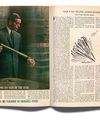
When, in 2009, the Berlin Philharmonic launched the Digital Concert Hall, a streaming-video platform for its concerts, the orchestra had no particular need to bolster its reputation. For decades, the Philharmonic had reigned as the world-champion musical heavyweight. Established in 1882, it had been led by a procession of luminaries: Hans von Bülow, Arthur Nikisch, Wilhelm Furtwängler, Herbert von Karajan, Claudio Abbado, Simon Rattle. And yet the distinctive Berlin sound-I've compared it, over the years, to a Rembrandt interior, a Russian men's choir, and deep-focus cinematography has never relied on the elevating powers of any one maestro. Indeed, members of the Philharmonic are more likely to ask whether conductors have risen to their level. Rattle, who departed in 2018, described them as a company made up of leading actors. They are intelligent, argumentative, self-aware. When they are of one mind, the concert stage knows nothing more potent.
Still, the Digital Concert Hall has had a pronounced influence: it has humanized a group that can intimidate audiences as much as it does conductors. Olaf Maninger, a member of the cello section, came up with the initial idea for the platform, and over the years the setup has grown increasingly sophisticated, with eight stationary cameras, two control rooms, and banks of monitors. During the Philharmonic's most recent American tour, in November, I could tell that some spectators around me were Digital Concert Hall regulars. "There's Sarah Willis," someone would say, as the French horns took their seats. "There's Stefan Dohr." The cameras often focus on the principals, but they also show the collective personality of the various sections: the double-basses, with their eerily unanimous pizzicatos, or the violas, with their smoldering tremolos. What distinguishes the Berliners from other orchestras is that they seem to dig into each phrase a little more. You can see this as readily as you can hear it.
This story is from the {{IssueName}} edition of {{MagazineName}}.
Start your 7-day Magzter GOLD free trial to access thousands of curated premium stories, and 9,000+ magazines and newspapers.
Already a subscriber ? Sign In
This story is from the {{IssueName}} edition of {{MagazineName}}.
Start your 7-day Magzter GOLD free trial to access thousands of curated premium stories, and 9,000+ magazines and newspapers.
Already a subscriber? Sign In
Techniques and cIdiosyncrasies

FEAR FACTOR
How the Red Scare reshaped American politics.

PLAYTIME
The old film studios had house styles: M-G-M’s was plush and sentimental, Warner Bros.’ stark and intense.

TIME AND PLACE
“Tatlin: Kyiv” explores a Russian Constructivist’s Ukrainian identity.

MOURNING BECOMES HER
Akram Khan’s “Gigenis: The Generation of the Earth.”

TEXAS ROUNDUP
How Greg Abbott made his state the staging ground for Donald Trump's mass-deportation campaign.

HOUSE CALL
To rent or to buy is the eternal question.

INDESCRIBABLE
The human disaster of the Irish famine.

Louisa Thomas on John Updike's "Hub Fans Bid Kid Adieu"
The original idea was an assignation. On a dreary Wednesday in September, 1960, John Updike, \"falling in love, away from marriage,\" took a taxi to see his paramour.

LIP SERVICE
Zyn and the new nicotine gold rush.